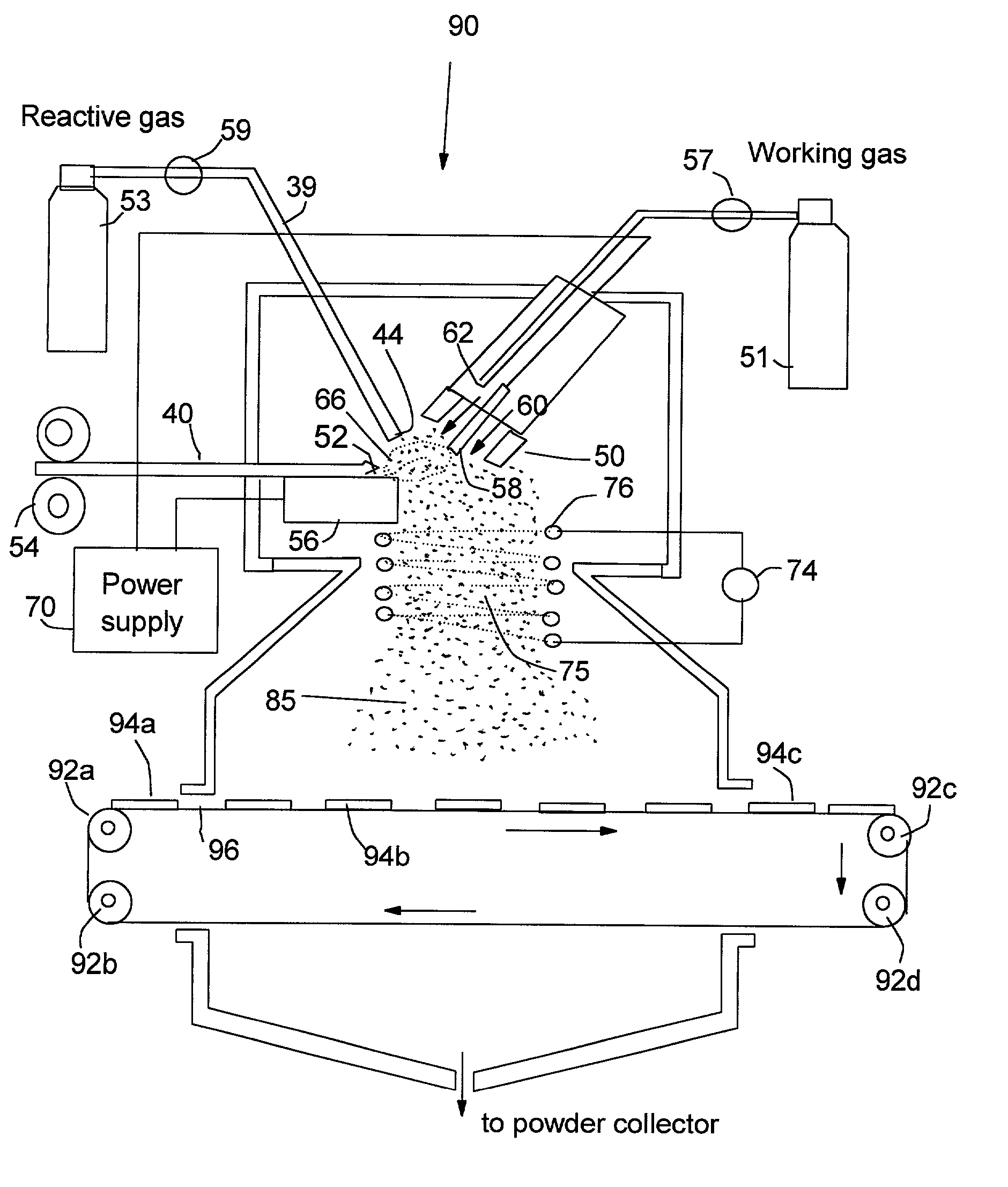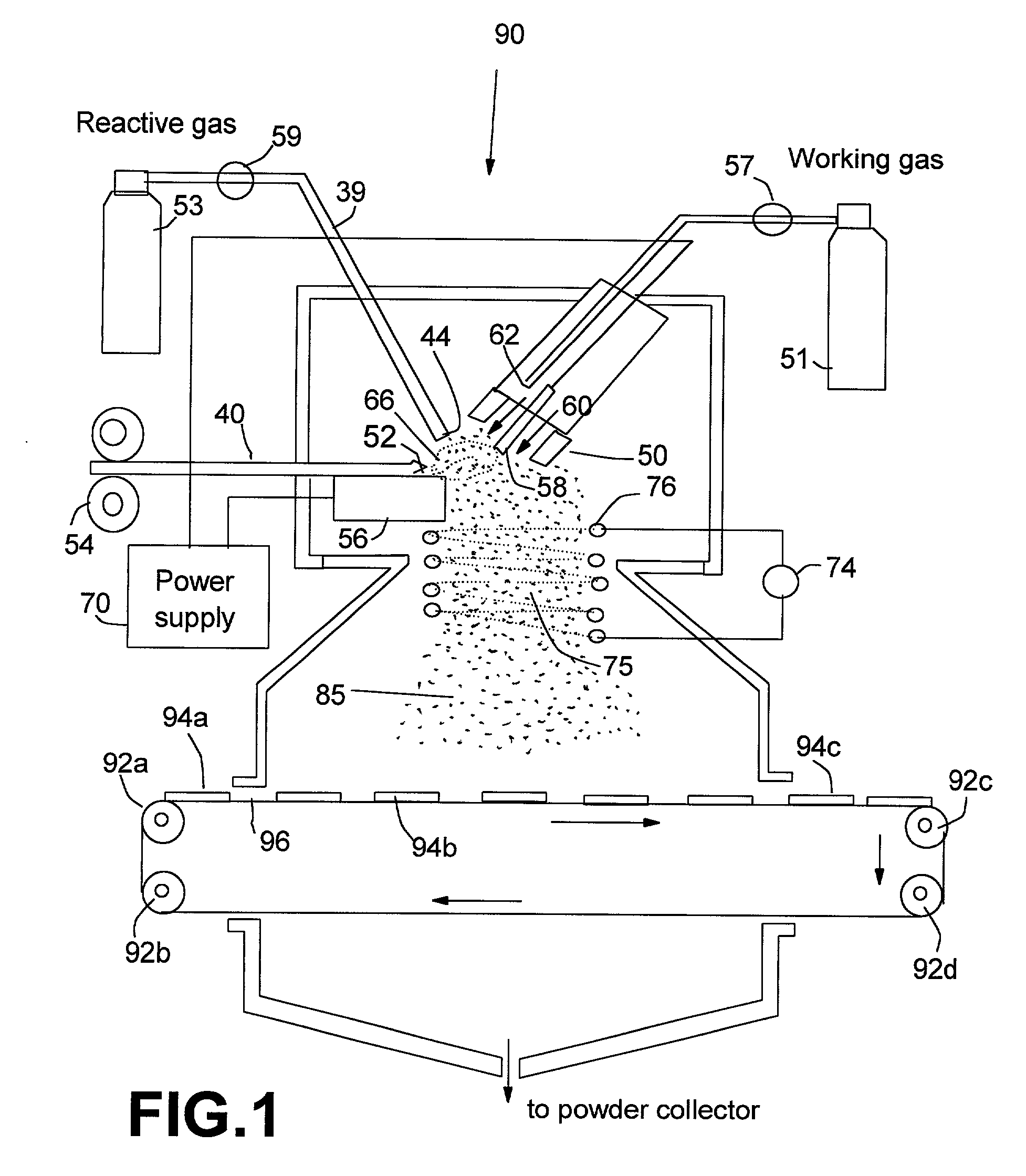Manufacturing method for transparent and conductive coatings
a manufacturing method and electro-conductive coating technology, applied in the direction of oxide conductors, non-metal conductors, conductors, etc., can solve the problems of difficult to obtain transparent electro-conductive coatings of low prices, low reproducibility and yield, and high cost, and achieve stable arcs. , the effect of easy heating of metal wires
- Summary
- Abstract
- Description
- Claims
- Application Information
AI Technical Summary
Benefits of technology
Problems solved by technology
Method used
Image
Examples
example 1
[0068] An Al—Cu metal alloy rod of ⅛ inch diameter was used as a precursor material disposed on a top horizontal surface of the consumable electrode. The non-consumable electrode, which was used as a cathode, was a material consisting of 2% thoriate dispersed in a matrix of W. This electrode was shielded by 25-100 cfh of a working gas of argon combined with 5-100% nitrogen and / or 5-50% hydrogen. The current of the arc was adjusted between approximately 100 and 450 amps, which generated an arc tail flame 1-4 inches long that evaporated the precursor material. The arc created a stream of metal vapor clusters of 1-200 g / hr while an oxygen flow of 10-1000 cfh was injected into the tail flame to form mixed oxide vapor clusters of the starting metal alloy. These vapor clusters were directed to deposit on a glass substrate. The micro-structure of the resulting coatings was typically characterized by grain sizes in the range of 1-50 nm. The room-temperature p-type conductivity of these coat...
example 2
[0069] A powder mixture of 70% tin and 30% indium was compounded into a rod ½ diameter by pressing and sintering. The rod was electrically conductive and used as a precursor material in the consumable electrode or anode. The same cathode as in Example 1 was used and shielded by approximately 50 cfh of a working gas of argon in combined with 5-50% nitrogen or 5-50% hydrogen. The current of the arc ranged from 100-450 amps. The precursor material was evaporated by the arc to produce a vapor of 1-200 g / hr in a plasma tail flame created by the transferred arc. Concurrently, 10-500 cfh oxygen was injected into the tail flame to produce complete indium-tin oxide vapor clusters. These oxide clusters were directed to deposit onto a glass. The coatings were found to be nano-grained with grain sizes of 5-35 nm. The room-temperature n-type conductivity of these coatings were approximately 5.5×103 S / cm.
example 3
[0070] The process of Example 2 was repeated except that tin was replaced by zinc. The resulting indium-zinc oxide coating exhibited grain sizes in the range of 3 to 25 nm. The room-temperature n-type conductivity of these coatings were approximately 3.5×10 3 S / cm.
PUM
| Property | Measurement | Unit |
|---|---|---|
| Temperature | aaaaa | aaaaa |
| Electrical conductivity | aaaaa | aaaaa |
| Electrical conductor | aaaaa | aaaaa |
Abstract
Description
Claims
Application Information
 Login to View More
Login to View More - R&D
- Intellectual Property
- Life Sciences
- Materials
- Tech Scout
- Unparalleled Data Quality
- Higher Quality Content
- 60% Fewer Hallucinations
Browse by: Latest US Patents, China's latest patents, Technical Efficacy Thesaurus, Application Domain, Technology Topic, Popular Technical Reports.
© 2025 PatSnap. All rights reserved.Legal|Privacy policy|Modern Slavery Act Transparency Statement|Sitemap|About US| Contact US: help@patsnap.com



